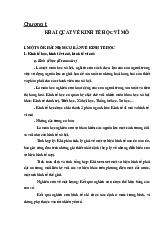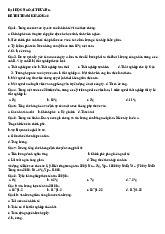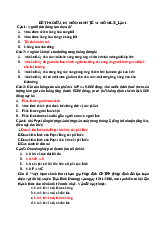











Preview text:
International Journal of Economics, Commerce and Management United Kingdom
Vol. V, Issue 10, October 2017 http://ijecm.co.uk/ ISSN 2348 0386
INFLUENCE OF INTEREST RATE, EXCHANGE RATE
AND INFLATION ON COMMON STOCK RETURNS OF
AMMAN STOCK EXCHANGE, JORDAN
Shadi Yousef Al-Abdallah
Instructor, Financial and Business Administration and Computer Science Department,
Al- Zarqa University College, Al-Balqa Applied University, Jordan bmshadi@bau.edu.jo
Nada Ibrahim Abu ALjarayesh
Master in Finance and Banking Sciences, Jordan Abstract
This research covers the influence of interest rate, exchange rate and inflation on stock returns
of ASE Free float index. The three macro variables which are taken under consideration are
deemed very major for the economy of any country. Therefore, any change among these
variables consequence the economy in different ways. Thus, the authoritarian takes step in
order to make adjusts in their rules which can involve the economy in a positive way. Ten years
monthly data from 2005 to 2015 is taken in contemplation. Multiple regression models are
applied on the data where result shows that firms are negatively correlated to interest rate and
positively correlated to inflation with zero relationship with exchange rate and stock returns.
Also, R square shows a weak relationship between independent and dependent variables.
Keywords: Interest rate, Exchange rate, Inflation, ASE index, Stock returns INTRODUCTION
Macroeconomic variables influence the performance of the stock market. Investors think about
macroeconomic variables when they value stocks. Interest rate, exchange rate and inflation are
very essential amongst these macroeconomic variables which affect the performance of the
stock market. Interest rate is contrariwise interrelated to stock prices as well as exchange rate.
Licensed under Creative Common Page 589
Downloaded by HOAN NGUYEN THI THU (nguyenthithuhoan_s16@hus.edu.vn) ©Author(s)
Interest rate is defined as the cost of borrowing. Also it used as a discount rate to discount
future cash flows of the financial assets. Increase in interest rate give rise to decrease in stock
prices because the required rate of return on stocks increase which causes decrease in stock prices (Lobo, 2000).
There is also a relationship between Exchange rate and stock market. So, foreign
investors exchange their returns on stocks in to their own currency. Foreign investors get
affected when local currency gets stronger and thus changed into weaker currency. Moreover,
exchange rate has negative relationship with stock prices. Therefore, stock prices diminish
when exchange rates boost and a decrease in exchange rate has positive impact on stock
market (Khan, et al., 2012).
A fast boost in inflation also involves negatively the performance of the stock market.
Growing inflation deemed as a bad news by the investors because it represents bad economic
conditions in the country. Therefore, investors are lacking confidence about their investment in
the stock market. In case of declining inflation rate, it illustrates good economic conditions and
catches the attention of investors to invest in the stock market (Khan, et al., 2012).
On top the discussion of interest rate, exchange rate and inflation have relationship with
stock prices. This study will be accomplished to test this relationship empirically. For this
purpose a case of Amman stock exchange (ASE) will be selected.
Amman Stock Exchange Market (ASE)
The Amman Stock Exchange (ASE) is an emerging stock market since its setting up on the 1st
of January, 1978. The ASE has contacts with the neighboring Arab stock markets. It is greatly
reliant on foreign capital inflows (deposition; and foreign investment), which consequently
improved the portfolio diversification and support products and liquidity. The Amman
stock market is experienced notable developments in rapid economic growth. This may be due
to the execution of the new Electronic Trading System (ETS). That’s why measures the
effect of inflation, interest rate and exchange rate on stock prices in emerging markets have
more than a few features as: being more elusive, more volatile, often accompanied by thin
trading-volumes and it is vulnerable to more handling compared to mature markets (Assaleh et al., 2011).
ASE was established in March 11-1999 as a result of the reformation process of the
Jordan Capital Market. It is described as a non-profit, private organization with administrative
and financial independency, authorized to exchange trading securities. In addition, ASE is an
efficient market for trading securities, hence it offers an attractive and safe environment for
investment, develops processes and systems of trading securities in the stock market, meets
Licensed under Creative Common Page 590
Downloaded by HOAN NGUYEN THI THU (nguyenthithuhoan_s16@hus.edu.vn)
International Journal of Economics, Commerce and Management, United Kingdom
the newest international standards, and publishes trading information to the largest possible
number of participants. Then in 1997 the Law, No.23 was issued as a turning point for the
Jordanian capital market. The Law offered three new institutions to replace AFM which are:
1. Jordan Securities Commission (JSC) 2. Amman Stock Exchange (ASE)
3. Securities Depository Center (SDC)
JSC is responsible of identifying regulations and monitoring the market and SDC is responsible
of managing settlements and maintenance of ownership records. In fact, ASE is one of the
largest stock markets in the region that allows foreign investment. Problem Statement
The stock return of firms diverges extensively with the changes in financial risk. It guides
academics and investors to pay attention to look at exchange rate and inflation and interest rate
exposure in Amman stock exchange market. Firms may have the same characteristics in a
given month, be evidence for returns that are diverse from the other companies. The arbitrage
pricing model provides investors a methodical way of relating how expected security returns
must relate with the economy. All Exchange rate uncertainty and inflation and interest rate
fluctuations effect multinationals and domestic firms. Objective of the Study
The objective of the study is to examine impact of interest rate, exchange rate and inflation on stock returns of ASE.
Significance of the Study
Interest rate risk occurs due to alter in interest rate. The connection between interest rate and
stock price return is contrariwise connected. While, exchange rate movements impact directly or
indirectly many resolutions of the domestic in addition to international companies. Performance
of the stock market is very vital to investors and they respond to macroeconomic variables
which may change the performance of the stock market. Interest rate, exchange rate and
inflation are the key macroeconomic variables which affect the market. This study will assist the
investors by giving that experimental proof of interest rate, exchange rate and inflation therefore;
it will help in their decision-making.
Licensed under Creative Common Page 591
Downloaded by HOAN NGUYEN THI THU (nguyenthithuhoan_s16@hus.edu.vn) ©Author(s)
Hypotheses of the Study
1. Exchange rate has no significant impact on common stock returns.
2. Inflation rate has no significant impact on common stock returns.
3. Interest rate has no significant impact on common stock returns. LITERATURE REVIEW
Output, the Stock Market, and Interest Rates (Blanchard, 1981)
Interest rate, exchange rate and inflation have some effect on the performance of stock market
(Blanchard, 1981). He stated the interface between output and the stock market. He
represented the connection of output, stock market and interest rates. Blanchard assured that
higher stock money lowers interest rate. This means that lower cost of capital and in turn
causes better stock market value. He reviewed that adjust in the rules for the reason that adjust
in the stock market, because of real interest rate and anticipated profits. The publication of a
rule shows the way to change in profits and discount rates. In turn it affects the performance of stock market.
Impact of interest rate, exchange rate and inflation on stock returns of KSE 100 index
(Khan, et al. 2012): covers the impact of interest rate, exchange rate and inflation on stock
returns of KSE 100 index. All the three macro variables are taken under consideration. They are
considered very important for the economy of any country and any change among these
variables affect the economy in various ways. In addition to that the regulatory authority takes
steps in order to make changes in their policies which can affect the economy in a positive way.
Ten years monthly data from 31st July, 2001 to Jun 30th 2010 is taken in consideration. Multiple
regression models are applied on the data, the result shows that there is a weak relationship
between the dependent variable and independent variables. The impact of interest rate and
inflation is insignificant on stock returns of KSE 100 index while the exchange rate has
significant impact on stock returns of KSE 100 index.
The Impact of Macroeconomic Factors on Amman Stock Market Returns(El-Nader &
Alraimony2012): the principle idea of this study is to examine the impact of macroeconomic
factors on ASE. Returns are provided by monthly data between (1991and 2010). This study
employs six macroeconomic factors: just three related to our study, consumer price index (CPI),
real exchange rate (E1), weighted average interest rates on loans and advances (WAIR). The
normality test, unit root and OLS, ARCH /GARCH models tests are applied to the data. The
OLS estimations are inefficient due the existence of serious autocorrelation and a sign of
Multicollinearity, and are inconclusive. However, the results of the ARCH (1) estimation showed
that CPI, E1, WAIR have a negative function on the ASE returns.
Licensed under Creative Common Page 592
Downloaded by HOAN NGUYEN THI THU (nguyenthithuhoan_s16@hus.edu.vn)
International Journal of Economics, Commerce and Management, United Kingdom
The Factors that affect shares’ Return in Amman Stock Market (Qudah 2012): This paper tests
the most important factors that affect the stock return and the excessive volatility. These
variables are obtained from the period (2005-2010).the regression model was applied on 15
listed Industrial companies in Amman Stock Exchange (ASE). The results of this study show
that the (interest rate and inflation rate) insignificant at 0.05 levels, which mean that each of
them does not affect the stock return.
The Relationship between Amman Stock Exchange Index and the Exchange Rate Using
Granger Causality Test (Dayyat 2012): This study investigates the relationship between the
Exchange Rate and Amman Stock Exchange Index between (1989-2004).Granger Causality
Test has been applied using data gathered from monthly and annual analytical reports from the
Central Bank of Jordan and Amman Stock Exchange reports. A lot of previous studies have
found that Exchange Rates and Stock Prices have predictive ability for each other. The results
of this study show that there is no relationship between the Exchange Rate and Amman Stock Exchange Index.
Impact of Economic Factors on the Stock Prices at Amman Stock Market (1992-2010) (
Momani and alsharari 2012): This paper investigates the effect of macroeconomic factors
(interest rate, national product, money supply and industrial product index) on stock prices at
Amman Stock Exchange, and to measure the impact of these factors on the general index of
prices and the index for each sector (bank, industrial, insurance and services), for the time
period from 1992 to 2010.The results of this study show that all factors of study have a
significant statistical impact on share prices, in other side there are difference when we test
each factor with the index (general, bank, industrial, insurance and services) the result show the
interest rate has a statistically significant impact on the prices of the shares in Amman stocks
exchange, negative effect on behalf of the index and the sectors index. The rest variable, which
had a significant impact, was the production index where its impact was negative for general
and sectors index except the insurance sector, which had a positive impact.
The relation between stock returns and short-term interest rates (Choi and Jen 1991):
This study report that the expected returns on common stocks are systematically related to the
market risk and the interest-rate risk. The findings of the study indicate that the interest-rate risk
for small firms is a significant source of investors' portfolio risk and the interest-rate risk for large
firms is "negative". The study also shows that the interest-rate risk premium explains a
significant portion of the difference in expected returns between the top quintile and the bottom
quintile of the NYSE and the MEX firms. Humpe and Macmillan (2007) also indicate both US
and Japan stock prices are negatively correlated to a long term interest rate.
Licensed under Creative Common Page 593
Downloaded by HOAN NGUYEN THI THU (nguyenthithuhoan_s16@hus.edu.vn) ©Author(s)
The Impact of Macroeconomic Variables on the Returns of Listed Stocks at Palestine
Exchange: Economic Sectors Model (Abusharbeh & Abdel Karim 2016): this paper investigates
the impact of economic factors on returns of Palestine Stock Exchange(PEX) and to test the
validity of Arbitrage Pricing Theory (APT) in the context of Palestine. all listed firms at Palestine
Exchange used as a sample. This paper test the main macroeconomic variables, such as
interest rate, exchange rate, inflation, unemployment rate, and GDP per capita. The result show
difference between firms. the interest and consumer price index have positively significant effect
on the returns of banking and investment firms. But GDP per capita has a positive effect on the
returns of insurance companies. While the exchange rate and unemployment rate have no
significantly impact on stock returns in case of PEX.
Does inflation has an impact on Stock Returns and Volatility? Evidence from Nigeria and
Ghana (Rano 2011): This study seek to test the effect of inflation on stock market return and
volatility in Nigeria and Ghana. It was found from the model’s returns that the volatility for
Nigeria’s market were significant but insignificant for the market Ghana. Market volatility was
affected by inflation in both of the countries. An decrease in inflation caused an increase in
market volatility but it was insignificant for the market of Ghana.
Furthermore, a lot studies carried out about this topic as Tabak (2006) indicates that
there is no long-run relationship, but there is linear Granger causality from stock prices to
exchange rates, in line with the portfolio approach Brazilian stock prices to exchange rates with
a negative correlation. add to that the study shows evidence of nonlinear Granger causality from
exchange rates to stock prices. The study of Horobet and Ilie (2007) offer contradictory results
for Romania. While the application of the Engle-Granger methodology indicates no cointegration
between the exchange rates and the stock prices, the use of the Johansen-Juselius procedure
suggests the presence of cointegration between the two stock market indices and the exchange
rates, either nominal bilateral, nominal effective or real effective rates. The study of Rasheed
(2002) applied for south Asian countries i.e. Pakistan, India, Bangladesh and Sri Lanka, to test
the impact of exchange rates on the stock returns in long and short run fluctuations in exchange
rates. The study found no relation for both long and short run between stock returns and
exchange rates for all countries.
In these two studies where applied in turkey ,Muradoglu and Metin (1996) indicate that
the negative relation between stock prices and inflation persists when other monetary variables
are included in the model. Ozturk (2008) shows that there is no causal relationship between inflation and stock returns
Licensed under Creative Common Page 594
Downloaded by HOAN NGUYEN THI THU (nguyenthithuhoan_s16@hus.edu.vn)
International Journal of Economics, Commerce and Management, United Kingdom METHODOLOGY
The population of this research is all companies listed on the Amman Stock Exchange of
Jordan. The data used in the empirical analysis is mainly secondary data collected from Central
bank of Jordan and ASE published report for the period 2005 to 2015. Data on Treasury bill
rates and exchange rates is collected from mixture of statistical bulletin issued by Central Bank
of Jordan. Stock prices data is taken from Amman Stock Exchange (ASE).
In this study we are examining the impact of interest rate, exchange rate and inflation on
stock returns of ASE free float index. For this reason monthly data of six month Treasury bill
rate, exchange rate and inflation from, 2005 to 2015 is selected. Stock returns will be
considered by computing change of ASE free float index points. So, multiple regressions are
used to experiment the hypothesis. Whereas interest rate, exchange rate and inflation are
independent variable and stock returns are dependent variable. Interest rate is 9th month
Treasury bill rate and for exchange rate JD to $ rate is selected.
To examine the macroeconomic risk factors that influence the stock returns in this study;
we employs multivariate regression analysis to explore the dependence of returns of firm on
interest rate, foreign exchange rate, and inflation. Thus, the regularly approximate disclosure model looks like:
R = + ER + IR + INF + i 0i 1 2 3 i,t (1) to
Where, Ri is the stock return, 1
3 are the coefficients of concerned variables, and
i,t is the error term of firm i at time t. While ER is the exchange rate (US Dollar Vs JD), IR is
the interest rate (6 months treasury bills), and INF is the inflation (CPI is used).
The control variables being used are measured by stock return (free float index) natural log.
Stock returns of firm can be calculated by using following equation: ( ) ln P Real stock returns= P t −1 t (2) P P Where,
t the ending return and
t −1is the beginning return.
The change in the foreign exchange rate is calculated by employing the End of Period JD /
$US exchange rate (Hassan and Javed, 2009) and the change in value is worked out through log differencing, i.e. FER ln t
Change in Foreign Exchange Rate = FER t −1 (3)
Licensed under Creative Common Page 595
Downloaded by HOAN NGUYEN THI THU (nguyenthithuhoan_s16@hus.edu.vn) ©Author(s) ANALYSIS
This section presents an empirical analysis of the effect of macroeconomic factors on common stock returns.
Table 1: Brief summary of descriptive statistics N Minimum Maximum Mean Std. deviation Returns 132 -.250182396 .1498308106 -.002285316 .0493312366 ER 132 .0 .0 .000 .0000 INF 130 -.035163912 .0586126836 .0033355809 .0091207406 IR 132 -.014000330 .0131273779 -.000257614 .0024078570 Valid N (listwise) 130
Table (1) shows a brief summary of descriptive statistics. The average return of free float index
in percentage terms are -2.2% with a standard deviation of 0.04%. The maximum returned of
ASE listed firm is 0.14 whereas maximum loss is 0.25. The average change in T-bill rate in
Jordan appears to be 0.0022 with a standard deviation of 4%. The average change in value of
Jordan currency is 0% with a standard deviation of 0%. Table 2: Correlation Matrix Returns Exchange rate Inflation Interest Rate Returns 1 0 ER 1 INF 0.18650504 0 1 IR -0.19843419 0 -0.13104362 1
Table (2) presents results of correlation matrix to ensure that there is no existence of
multicollinearity. According to results returns of the firms are negatively related to interest rate
and, whereas positively related to inflation, and zero relationship with exchange rate. The
highest positive correlation is 0.18 between return of the firm and inflation whereas highest
negative correlation is -0.198 which shows that multicollinearity is not present among the selected variables.
Licensed under Creative Common Page 596
Downloaded by HOAN NGUYEN THI THU (nguyenthithuhoan_s16@hus.edu.vn)
International Journal of Economics, Commerce and Management, United Kingdom
Table 3: Regression Statistics Multiple R 0.2560995231699763 R Square 0.06558696576788922 Adjusted R Square 0.04334800399684875 Standard Error 0.04805429819298206 Observations 132
Summery output of the regression model shows that the R square is 6.5 % which means that
regression model approximated 6.5 % variation in dependent variable with standard error of 4.8
%. R square shows a weak relationship between independent and dependent variables. Table 4: ANOVA Analysis Df SS MS F Significance F Regression 3 0.02090898 0.00696966 4.5272905 0.00473 Residual 129 0.297888809 0.00230922 Total 132 0.318797789
ANOVA shows that the overall model is significant with F value of 0.004 (F= 0.004 < 0.05). The
result of ANOVA table confirmed that the predicted model is significant at 5% significance level. Table 5: Coefficient Analysis Coefficients Standard Error t Stat P-value Intercept -0.006197406 0.004468094 -1.3870356 0.1678228 0 0 65535 0 ER INF 0.889609908 0.467663803 1.90224239 0.0593688 IR -3.627003679 1.758843644 -2.0621524 0.0412006 Hypotheses Testing
1. Exchange rate has no significant impact on common stock returns.
The results in Table 5 were used in testing this hypothesis. This hypothesis was tested using
the reject/accept decision criterion. Table (5) shows the intercept and the coefficients of the
regression model. Result of the regression model shows that exchange rate has zero impact on
stock returns and significant at 5% significant level (P = 0 < 0.05). It indicated that there is no
Licensed under Creative Common Page 597
Downloaded by HOAN NGUYEN THI THU (nguyenthithuhoan_s16@hus.edu.vn) ©Author(s)
relationship between the Exchange Rate and common stock returns.This hypothesis could be
acceptedbecause the Jordanian Dinar is pegged to the US dollar might be. Foreign investors
convert their returns on stocks into their home currency. Zero exchange rate results in lower
returns when converted in to other currency which disappoint the foreign investors. In a related
study, Dayyat (2008) by using Granger Causality Test find out no relationship between
exchange rate and common stock returns. But that contrast with El-Nader & Alraimony (2012)
study where they found negative relationship
2. Inflation rate has no significant impact on common stock returns.
According to Table5 .The coefficient of inflation is 0.88 which shows inflation has an impact on
stock returns but this result is significant because (P = 0.05 = 0.05) that is indicate to significant
and positive relationship between inflation and common stock returns. This hypothesis could be
rejected. Our result similar to (Rano & Bayero, 2010) which show the effect of inflation on stock
market return and volatility in Nigeria and Ghana. They found Market volatility was affected by
inflation in both of the countries
In a related study, Khan, et al., (2012) covers the impact of interest rate, exchange rate
and inflation on stock returns of KSE 100 index. They find out inflation is insignificant on stock
returns of KSE 100 index, that consist with AL – Qudah (2012) study.
3. Interest rate has no significant impact on common stock returns.
The above stated hypothesis was tested using the regression results in Table 5. Interest rate is
negatively related (-0.036) to stock returns but significant as P = 0.04 < 0.05.then we reject this
hypotheses.In a related study, El-Nader & Alraimony (2012) show an inverse relationship
between interest rates & stock market returns. And Momani & Alsharari (2012) found that the
interest rate has a statistically significant impact on the prices of the shares in Amman Financial
Market, and the effect was negative on behalf of the index and the sectors index. Khan, et al.,
(2012) find out a weak relationship between the interest rate and common stock return. The
impact of interest rate is insignificant on stock returns of KSE 100 index.
The figure (1) below, it shows the relationship between returns and the other independent variables.
Licensed under Creative Common Page 598
Downloaded by HOAN NGUYEN THI THU (nguyenthithuhoan_s16@hus.edu.vn)
International Journal of Economics, Commerce and Management, United Kingdom
Figure 1. Relationship between returns and the other independent variables Figure 2. Histogram
Licensed under Creative Common Page 599
Downloaded by HOAN NGUYEN THI THU (nguyenthithuhoan_s16@hus.edu.vn) ©Author(s) Figure 3. P-P Plot CONCLUSIONS
This study examined the influence of interest rate, inflation and exchange rate on the stock
returns of ASE. Results of the multiple regressions pointed out a weak variation in the
dependent variable due to independent variables. Interest rate and inflation have significant
influence on stock returns of ASE. Exchange rate is zero related to stock returns of ASE free
float index. Moreover the result show positive relationship between inflation and stocks return
but negative relationship between interest rate and stocks return.therefore, the investors should
take into consideration the macroeconomic changes in determine of the prices of common
stocks.And the decision maker in Jordan represented by central bank of Jordan try to keep
moderate level of these factors (interest rate and inflation rate).
For the future research, it is recommended that more variables shall be taken as (GDP,
real money supply, balance of payments) in other studies in order to realize the influence of
other variables on stock returns. REFERENCES
AL–Qudah,L. (2012) The Factors that affect shares’ Return in Amman Stock Market. Interdisciplinary
journal of contemporary research in business, Vol. 4, No. 6, pp.1219-1231
Blanchard, O. J. (1981). Output, the Stock Market, and Interest Rates. The American Economic Review, Vol .71 ,No.(1), pp. 132-143.
Choi, D. and Jen, F. C. (1991), The Relation Between Stock Returns and Short-Term Interest Rates,
Review of Quantitative Finance and Accounting, Vol. 1, pp. 75-89
Licensed under Creative Common Page 600
Downloaded by HOAN NGUYEN THI THU (nguyenthithuhoan_s16@hus.edu.vn)
International Journal of Economics, Commerce and Management, United Kingdom
Dayyat ,R. (2008) The Relationship between Amman Stock Exchange Index and the Exchange Rate
Using Granger Causality Test. Jordan Journal of Business Administration, Vol. 4, No. 3,PP.357-365
El-Nader,H .and Alraimony, A (2012) The Impact of Macroeconomic Factors on Amman Stock
MarketReturns, International Journal of Economics and Finance, Vol. 4, No12.
Horobet, A and Ilie, L. (2007), On The Dynamic Link Between Stock Prices And Exchange Rates:
Evidence From Romania, Munich Personal RePEc Archive Paper No. 6429, Online at http://mpra.ub.uni- muenchen.de/6429/
Humpe, A. and Macmillan, P. (2007), Can macroeconomic variables explain long term stock market
movements? A comparison of the US and Japan, Centre for Dynamic Macroeconomic Analysis Working Paper Series.
K. Assaleh, H. El-Baz and S. Al-Salkhadi.( 2011) Predicting Stock Prices Using Polynomial Classifiers:
The Case of Dubai Financial Market," Journal of Intelligent Learning Systems and Applications, Vol. 3, No. 2, pp. 82-89.
Khan.Z, et al. ( 2012). Impact of interest rate, exchange rate and inflation on stock returns of KSE 100
index, IJER ,vol. 3, no.5,pp, 142-155.
Lobo, B. J. (2000). Asymmetric Effects of Interest Rate Changes on Stock Prices. The Financial Review , Vol. 35, NO.3,PP. 125-144.
Momani,G. and alsharari,M.( 2012) Impact of Economic Factors on the Stock Prices at Amman Stock
Market (1992-2010), International Journal of Economics and Finance, Vol. 4, No1
Muradoglu, G. And Metin, K. (1996), Efficiency of the Turkish Stock Exchange with respect to monetary
variables: A cointegration analysis, European Journal of Operational Research, Vol. 90, Issue 3, pp. 566- 576
Ozturk, B. (2008), The Effects of Macroeconomic Factors on Istanbul Stock Exchange National 100 Index
and Its Volatility (1997-2006), Thesis, Istanbul Technical University (in Turkish)
Rano, S. U. (2011). Does inflation has an impact on Stock Returns and Volatility? Evidence from Nigeria
and Ghana, International Conference on Economics and Finance Research IPEDR vol.4
Tabak, B. (2006), The Dynamic Relationship Between the Stock Prices and Exchange Rates: evidence
for Brazil’, Banco Central Do Brasil, Working Paper Series 124.
Licensed under Creative Common Page 601
Downloaded by HOAN NGUYEN THI THU (nguyenthithuhoan_s16@hus.edu.vn)





